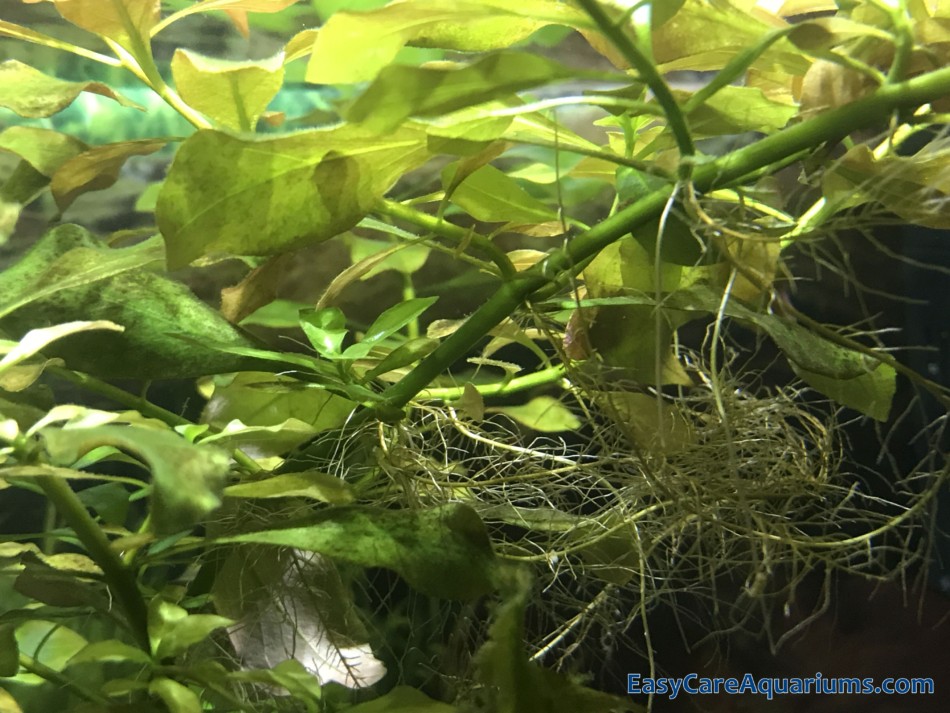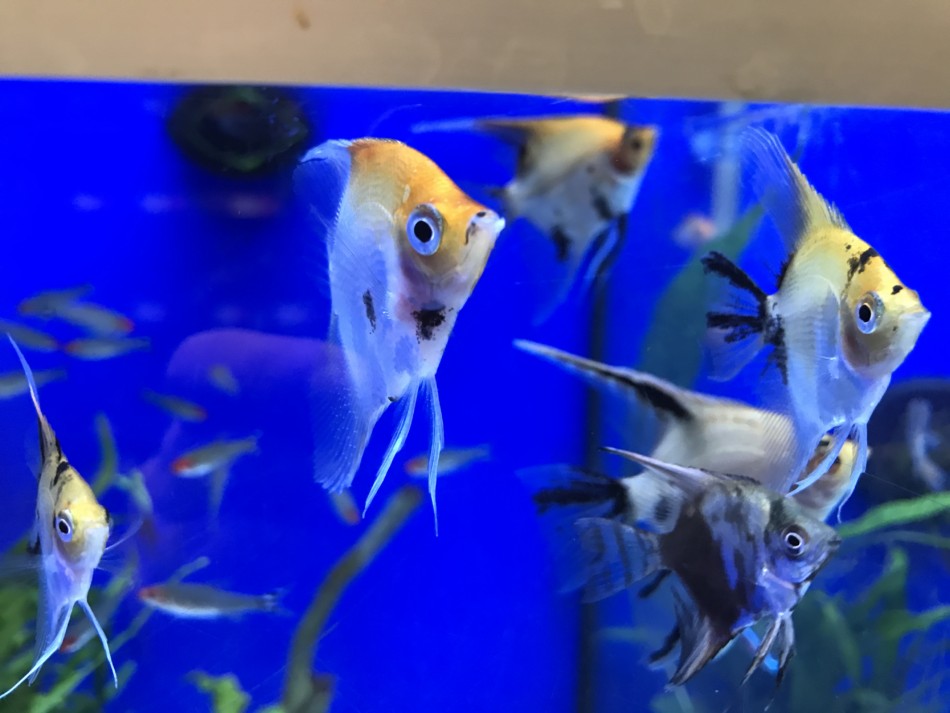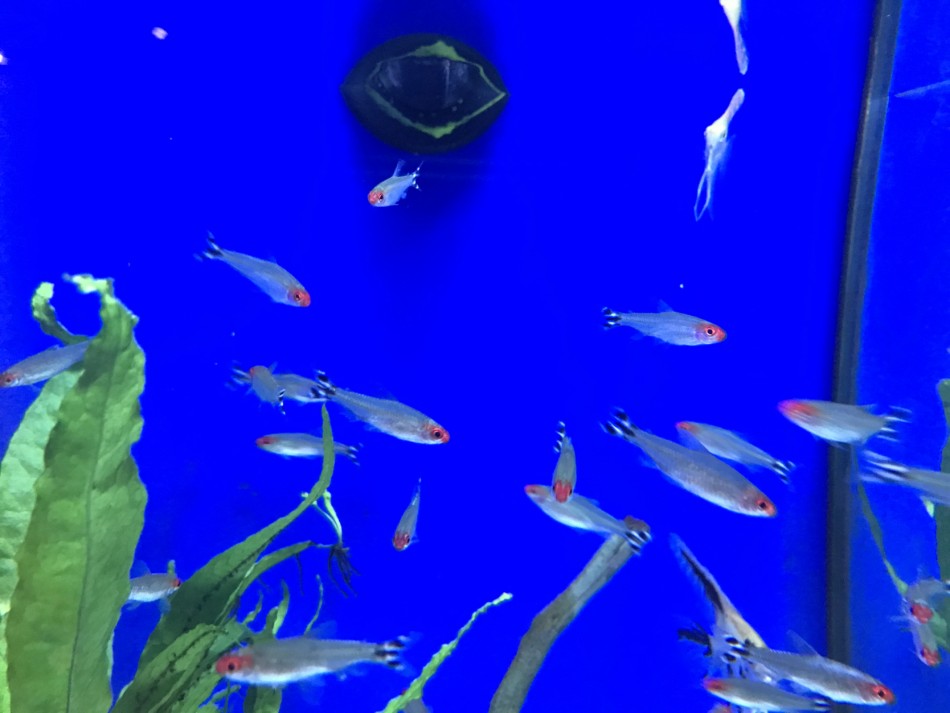This article may contain some affiliate links to products. The links provide me a small percentage of commission but do not cost you anything extra to use. (See full disclosure statement here ).
).
Although Rummy Nose Tetras are an easy-care tropical fish they do better if you give them the right tank setup. Luckily this is easy to do as long as you take a few important points into consideration.
The best tank setup for Rummy Nose Tetras is one that includes plenty of plants, a slow to moderate flow and a medium light level. Because they are a tropical fish the tank water needs to be heated. The water also needs to be clean and oxygenated. The addition of rocks/pebbles, leaf litter and wood all help to create a more natural environment.
Whether you’re setting up a Rummy Nose Tetra only tank, or starting off/adding them to an existing community tank, you can keep things easy-care. It doesn’t need to be complicated when it comes to keeping these striking tetras happy and healthy.
In this article I will be explaining how to set up a fresh water tank for your Rummy Nose Tetras. I’ll also be giving you some information and tips about adding them to, or building up, a Rummy Nose friendly community tank.
Tip: Decide how many Rummy Nose Tetras you want to keep before buying a tank. If you buy the tank first the size of the tank will dictate how many of them you can keep. If you’re adding Rummy Nose Tetras to an existing community tank you need to take both the tank size, and the number of established inhabitants, into account before buying more fish.
Choosing A Tank For Your Rummy Nose Tetras
Rummy Nose Tetras are a schooling fish which means that they prefer to live in groups. So It’s best to keep at least 6 Rummy Nose Tetras together as a minimum number. When it comes to how many to keep together it’s a case of ‘the more the merrier’. And a large school of these tetras moving together across the tank makes an impressive display.
Once you’ve decided on how many Rummy Nose Tetras you want to keep you can start looking for the right tank.
Because Rummy Nose Tetras are a small fish you don’t have to have a huge tank. Which is just one of the reasons why they are a good beginner fish. Although you will need a decent sized tank if you want to keep a larger school of them.
And it’s important to remember that they are an active fish that swim around energetically most of the time. Which means that they need plenty of swim-room, particularly mid to top of the tank.
So it’s important that the tank gives them enough space to do this without being cramped.
It’s always best to buy the biggest tank that your budget and available space will allow.
Tip: Rummy Nose Tetras swim from one side of the tank to the other all day long. So a tank that is wider than it is tall is a good option.
So What Size Tank Do Rummy Nose Tetras Need?
The tank size you will need for your Rummy Nose Tetras will depend on a few things. It’s a good idea to take the points below into account before buying an aquarium.
- The number of Rummy Nose Tetras you want to keep
- The size of Rummy Nose Tetras when they are full grown (average 2-2.5 inches/5.08-6.35 cm).
- Plenty of room for plants but leaving plenty of swim-room for the fish too
- Room for any other fish/shrimp/snails that will share the tank
- Spare litres/gallons in case your Rummy Nose Tetra fry (babies) reach maturity or their tankmates breed
If you would like more information about how Rummy Nose Tetras reproduce read my article ‘How Do Rummy Nose Tetras Breed? ‘
‘
As you can see from the list above there are a few basic things to consider when you’re choosing the right tank for your Rummy Nose Tetras. And it’s impossible for me to tell you what size tank to buy because I don’t know exactly what you have in mind.
My advice though is to make a plan taking all of the points above into account. Then speak to your local Pet Store or Aquatic Dealer for advice on a suitable tank that will comfortably accommodate all of your planned inhabitants and will also allow room for possible fry.
There’s no ‘one-size-fits-all’ when it comes to choosing the right tank for your fish. So having a plan and getting some guidance is a great help. Particularly if you’re new to the fish keeping hobby.
Note: It’s always better to understock rather than overstock a tank, particularly in a new tank setup. If you add too many fish at once you run the risk of an ammonia spike which can be fatal to your fish.
Tip: Rummy Nose Tetras can, and do, jump out of the tank. And not just because something has spooked them either. It’s just something that they do. So it’s best to have a close fitting lid on your aquarium to prevent any losses.
What’s The Best Tank Layout For Rummy Nose Tetras?
Rummy Nose Tetras are an easy-care fish that are not too fussy about their tank layout. But that doesn’t mean that you shouldn’t do your best to give them at least the basic things that make them feel at home in your aquarium. The closer you make the tank environment to their native habitat the happier they will be.
Rummy Nose Tetras are native to the Amazon Basin but can also be found in other areas such as Columbia and Brazil. Despite the different areas their habitat is pretty similar. The water is warm and slightly acidic for the most part. And the rivers also contain plants, leaf debris, rocks and pebbles.
I know that keeping fish in any tank setup isn’t going to be the same as their native environment. No matter how much you try to replicate it. However, most of the fish we buy from Pet Stores/Aquatic Dealers have been captive bred for many generations and are generally adapted to aquarium life already. But that doesn’t mean that we shouldn’t do our best to make their lives as comfortable as possible. And if the fish are happier they’re less likely to suffer from stress and stress related illnesses.
A Good Tank Layout For Rummy Nose Tetras Generally Includes:
- Plants – A planted tank is great for Rummy Nose Tetras. You can use stem, epiphyte and floating plants. A combination of all of these plant types is even better (there’s more information about plants/types both live and fake in the next section).
- Pebbles/Rocks
 – (Amazon link) You can use these to create a more natural look to the bottom of your aquarium.
– (Amazon link) You can use these to create a more natural look to the bottom of your aquarium. - Leaf Debris – Helps to create a more natural look and feel to the tank. Catappa Leaves
 (Amazon link) are a good choice because they release beneficial tannins into the water. But you can use other leaves too, such as Oak Leaves for example.
(Amazon link) are a good choice because they release beneficial tannins into the water. But you can use other leaves too, such as Oak Leaves for example. - Substrate –Sand/Coarse Sand
 (Amazon link) or Fine Gravel work well in a Rummy Nose Tetra tank. But any kind of substrate that you prefer will be okay for your Rummy Nose Tetras as they don’t really interact with the substrate.
(Amazon link) or Fine Gravel work well in a Rummy Nose Tetra tank. But any kind of substrate that you prefer will be okay for your Rummy Nose Tetras as they don’t really interact with the substrate.
You can also add pieces of Wood/Twigs (Amazon link) and Alder Cones to create a more natural ‘bottom of the river debris’ look. It all helps with the overall look and feel of the tank.
Tip: Make sure that any Wood/Twigs, leaves and/or Alder Cones etc are aquarium safe. This is particularly important if you forage for them yourself. Any natural tank debris needs to be pest and pesticide free or you risk poisoning your fish.
Even if you’re trying to create a more natural feel to your Rummy Nose tank it doesn’t mean that you can’t include other tank decorations too. You can add other things that you would like to see in your tank to make it look the way you want it to. Natural looking cave structures are a good choice in a Rummy Nose Tetra tank but you can add ‘fun’ decorations if you want to. Your fish won’t mind.

Do Rummy Nose Tetras Need A Planted Tank?
Rummy Nose Tetras do well in a planted tank. Not only do plants create a more natural environment they serve other purposes too. Plants make great places for your Rummy Nose Tetras to spawn in. They also provide safer areas for the wigglers/fry to hide in while they grow. Plus, live plants provide shelter and resting places for your adult fish.
If you’re not sure which plants to use, or you haven’t used live plants before, I’ve got some suggestions for you.
Easy-Care Plants For a Rummy Nose Tetra Tank
- Bacopa Plants – Different varieties – usually planted but some can be left to float
- Amazon Sword – Long narrow leaved plant (needs planting in the substrate)
- Hornwort – Feathery plant (can be planted, floated or attached to wood/rocks etc)
- Java Fern – Wide leaved plant (can be planted or attached to wood/rocks etc)
- Vallisneria Plants – Coarse grass-like plants usually planted in the substrate and will spread
- Java Moss, Christmas Moss, Weeping Moss– Feathery mosses (attach to wood/rocks, tank decorations)
- Floating Plants – Such as Salvinia, Amazon Frogbit and Red Root Floaters
There are a lot more easy-care aquarium plants that you can use in your Rummy Nose Tetra tank. Guppy Grass (carpeting), Water Wisteria (planted) and Dwarf Water Lettuce (floating) are just a few of the options you can choose from. But the plants on the list above will give you a good starting point.
And it’s worth noting that because Rummy Nose Tetras are known to jump if you have floating plants in your aquarium you will reduce the chances of your fish jumping out of the tank.
Check the plants out Online or at your local Pet Store or Aquatic Dealer. Then choose the plants that you want to keep in your aquarium to get the look you’re aiming for.
Tip: Because Rummy Nose Tetras swim across the whole width of the tank all day it’s best to plant your taller plants at the back. You need to keep plenty of clear swim room at the front of the tank especially mid to top height.
Artificial/Fake Plants
I know that not every fish keeper wants to keep live plants. The good news is that you don’t have to keep live plants in your Rummy Nose Tetra tank. You can use artificial/fake ones if you prefer. But it’s important to choose ones that have soft leaves and no sharp edges to reduce the risk of injuring your fish. And you need to bear in mind that you won’t get the natural ‘filtering’ benefits that live plants provide. Nonetheless, your Rummy Nose Tetras won’t mind that the plants aren’t real as long as they have a ‘planted’ back area.
If, over time, you decide to try some live plants in your tank the list and suggestions above will give you a good place to start.
Tip: When choosing a filter for your tank make sure it can cope with both the tank’s water capacity and the number of fish you are keeping. Some types of fish are messier than others, so remember to take that into account too.

Do Rummy Nose Tetras Need A Filter?
Rummy Nose Tetras need a filtered tank because their water needs to be clean, filtered and oxygenated. They don’t like dirty/poor water conditions. Tank filters not only help to clean the water they oxygenate the water too by moving the water around and breaking the water’s surface. The water movement creates flow in the tank and Rummy Nose Tetras, in an aquarium, prefer a slow to moderate flow.
Filters also serve another important purpose. They are great breeding grounds for the beneficial bacteria that help to keep your tank environment a healthy one.
Here Are Some Filter Options For Your Rummy Nose Tetra Tank
- Sponge Filter – A Sponge Filter
 (article link) run by an air pump provides efficient filtration and oxygenation while only producing a gentle/moderate flow. It also provides a surface area for beneficial bacteria to grow on and won’t suck in your fish or their fry. It’s cheap and easy to clean. And if you attach your sponge filter to an Adjustable Air Pump
(article link) run by an air pump provides efficient filtration and oxygenation while only producing a gentle/moderate flow. It also provides a surface area for beneficial bacteria to grow on and won’t suck in your fish or their fry. It’s cheap and easy to clean. And if you attach your sponge filter to an Adjustable Air Pump (Amazon Link) you can control the flow/filtration to suit your fish.
(Amazon Link) you can control the flow/filtration to suit your fish. - Internal Box Filter – This type of filter hangs or ‘suckers’ onto the inside of your tank. Often with the water return part above the water level creating a waterfall effect. But the way the water is returned will depend on the type of Internal Box Filter
 (Amazon link) you buy. Some are completely submerged which means you can’t see the filtered water being returned to the tank. Internal box filters can come with replaceable filter cartridges or a simple sponge insert. This type of filter is often included as part of a tank starter kit but can be bought separately.
(Amazon link) you buy. Some are completely submerged which means you can’t see the filtered water being returned to the tank. Internal box filters can come with replaceable filter cartridges or a simple sponge insert. This type of filter is often included as part of a tank starter kit but can be bought separately. - HOB Hang-On-The-Back Filter
 (Amazon link) – Just as it sounds this type of filter hangs on the back of the tank. The box part is on the outside of the tank and the intake tube sits in the water. The box part is filled with filter media of all kinds which you can change to suit the needs of your fish. The filtered water is returned to the tank via a lip/spout creating a waterfall effect.
(Amazon link) – Just as it sounds this type of filter hangs on the back of the tank. The box part is on the outside of the tank and the intake tube sits in the water. The box part is filled with filter media of all kinds which you can change to suit the needs of your fish. The filtered water is returned to the tank via a lip/spout creating a waterfall effect. - External Filter– An external filtering system sits outside of the tank. Usually under the tank stand/cabinet and is hidden from sight. The intake pumps the water out of the aquarium into a filtering unit. Then it pumps the water back in again through a return tube once it’s been cleaned. It does this on a regular cycle. However, unless you have a seriously large tank, or you’re running multiple tanks off the same filtration system, you’re unlikely to go for this option.
Tip: Even if you have an efficient filter in your Rummy Nose Tetra tank you still need to keep on top of your tank maintenance. Aquarium filters are a great help in keeping the water healthy but they should be used alongside your regular tank cleaning.
Do Rummy Nose Tetras Need A Tank Light?
Rummy Nose Tetras need regular periods of light and dark in their tank. One way, and the easiest way, to achieve this is to install a tank light. However, the light doesn’t need to be super bright. A medium lighting level is enough or you will find that your Rummy Nose Tetras spend a lot of time hiding in the plants. And the light needs to be turned off at night to allow them to rest.
Do Rummy Nose Tetras Need A Heated Tank?
The ideal temperature range for Rummy Nose Tetras is 22-26 Degrees Celsius (Approx. 72-80 Degrees Fahrenheit) but they can tolerate the water a little warmer. You will need a tank heater unless you live in a climate that will keep the water within this temperature range 24/7 all year round. And even then it’s best to keep the temperature stable rather than having it rise and drop. So a heater is needed if you’re going to keep Rummy Nose Tetras.
Tip: An easy way to check your tank temperature is to add a aquarium thermometer. They are cheap to buy and are a simple but useful tool for monitoring the temperature of your tank water. They are also a good way to check that your aquarium heater is working properly.
What Kind Of Water Is Best For Rummy Nose Tetras?
Rummy Nose Tetras aren’t fussy about water parameters as long as the tank water is clean and oxygenated. Despite the water in their native habitat being slightly acidic in general, they can adapt to different kinds of water without too much trouble. After all, the Rummy Nose Tetras you buy from a Pet Store/Aquatic Dealer or a local breeder, will have been born and raised in non-native water. Which means that, in general, your tap water treated with a dechlorinating product will be just fine.
The main point about the water quality in a Rummy Nose Tetra tank is that it’s kept clean, filtered and oxygenated. The easiest way to keep the water clean is to carry out weekly partial water changes and 4 weekly full tank maintenance alongside what your aquarium filter is doing on a 24 hour basis.
Don’t overfeed your Rummy Nose Tetras. Excess food fouls up the water causing dangerous levels of ammonia, nitrite and nitrate that can kill your fish. So don’t be tempted to give them just a little bit more food.
If you would like more information and tips about what/how much to feed your Rummy Nose Tetras, both the adults and the fry, click the link to read my article ‘What do Rummy Nose Tetra Eat?’
Tip: When you set up your Rummy Nose Tetra tank, and on all water changes, the water should be dechlorinated using a reputable water treatment product. These products not only eliminate Chlorine and Chloramines they also get rid of any heavy metals that might harm your fish.
Two Tap Water Treatments that are popular with fish keepers are Prime by Seachem and API Tap Water Conditioner (Amazon links) but there are other tap water treatments/conditioners available too.
and API Tap Water Conditioner (Amazon links) but there are other tap water treatments/conditioners available too.
Tankmates For Rummy Nose Tetras
The best tankmates for Rummy Nose Tetras are other small-medium non-aggressive fish. Any tankmates need to be peaceful in temperament and not big enough to see your tetras as a tasty snack. They can also share their tank with non-aggressive shrimp and snails that are suited to the tank setup.
Here’s Some Of The Fish/Shrimp/Snails That Make Good Tankmates For Rummy Nose Tetras
- Angelfish -Freshwater Angelfish make great tankmates for Rummy Nose Tetras. You’ll often see them kept in the same aquarium in Pet Stores and at Aquatic Dealers. If you’re interested in keeping Angelfish with your Rummy Nose Tetras check out my articles about keeping Angelfish.
- Other Small Tetras – e.g. Green Neon Tetras, Cardinal Tetras and Blue Neon Tetras
- Zebra Danios – plus other small peaceful Danios such as Celestial Pearl
- Dwarf Gourami – e.g. Pearl and Honey Gourami – plus other small peaceful varieties
- Platy Fish – All varieties/colours
- Molly Fish – All varieties/colours
- Corydoras Catfish – e.g. Bronze, Panda, Emerald (mainly inhabit the bottom of the tank area)
- Shrimp – Amano, Wood/Bamboo, Chery Shrimp (Note: Rummy Nose Tetras will eat baby shrimp)
- Snails – e.g. Nerite (all varieties) other types of snails that don’t have their ‘fleshy’ part exposed
Other options include: Yo-Yo and Kuhli Loaches, Hatchet Fish, Cherry Barbs and Harlequin Rasbora.
There are a lot of other options for tankmates in a Rummy Nose Tetra Tank. Just remember to avoid aggressive fish and fish that are big enough to eat your Rummy Nose Tetras. And also fish that are small enough for your Rummy Nose Tetras to eat.

Can I Add Rummy Nose Tetras To An Established Community Aquarium?
Rummy Nose Tetras are a great little fish to add to a peaceful community tank. As long as all the established fish, shrimp and snails are likely to get along with the Rummy Nose it’s definitely an option. Particularly if you want to increase the movement and activity in your aquarium.
In fact, Rummy Nose Tetras prefer an established/aged tank as their new home. Whether that’s a shared community tank or their own species only aquarium.
Bear in mind that Rummy Nose Tetras are a lively fish that swim from one end of the tank and back again all day long. So don’t add them to a tank whose fish are slow moving and are likely to be stressed by other fish constantly swimming around.
The Takeaway
I realise that in this article I’ve given you a lot of information about the Best Tank Setup For Rummy Nose Tetras. So I thought it was a good idea to create a simple list of the main points that I’ve covered.
Here’s The Takeaway
- Buy a tank that has plenty of swim-room for the number of Rummy Nose Tetras you want to keep. You’ll need at least 6 as a minimum number. Leave room for fry and any other tankmates too.
- Use plenty of plants either live and/or fake in the tank but keep the front area free for swimming.
- Include pebbles/rocks, leaf debris and/or wood, and a substrate of your choice, to create a more natural feel to the tank
- Filter the tank with a slow to moderate flow.
- Tank lighting needs to be at a medium level. Don’t have a super bright light.
- The ideal tank temperature is between 22-26 Degrees Celsius/Approx. 72-80 Degrees Fahrenheit but they can tolerate the water a little warmer. So you will need a tank heater to keep the temperature stable.
- Water quality should be clean, oxygenated, and free from a build up of toxins
- Tankmates need to be small-medium, non-aggressive, and happy to share the same tank conditions.
Rummy Nose Tetras are an active, easy-care fish, that will give you a lot of pleasure and create colour and movement in your aquarium.


